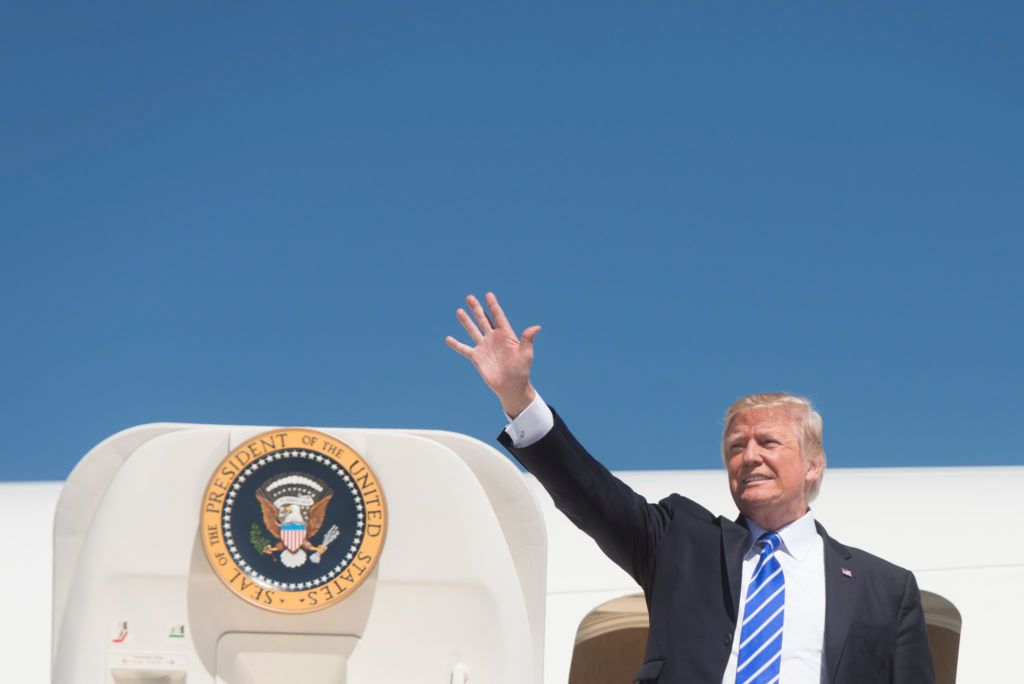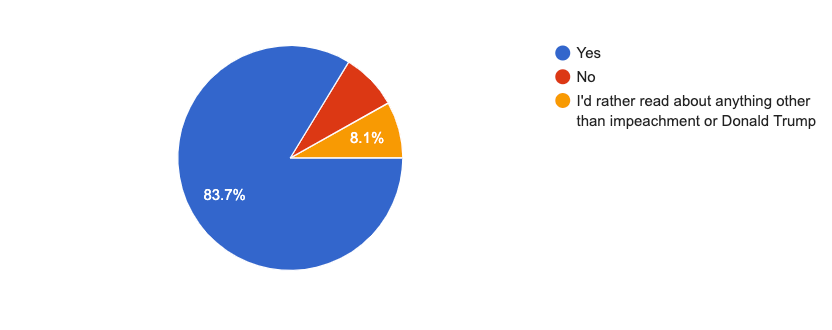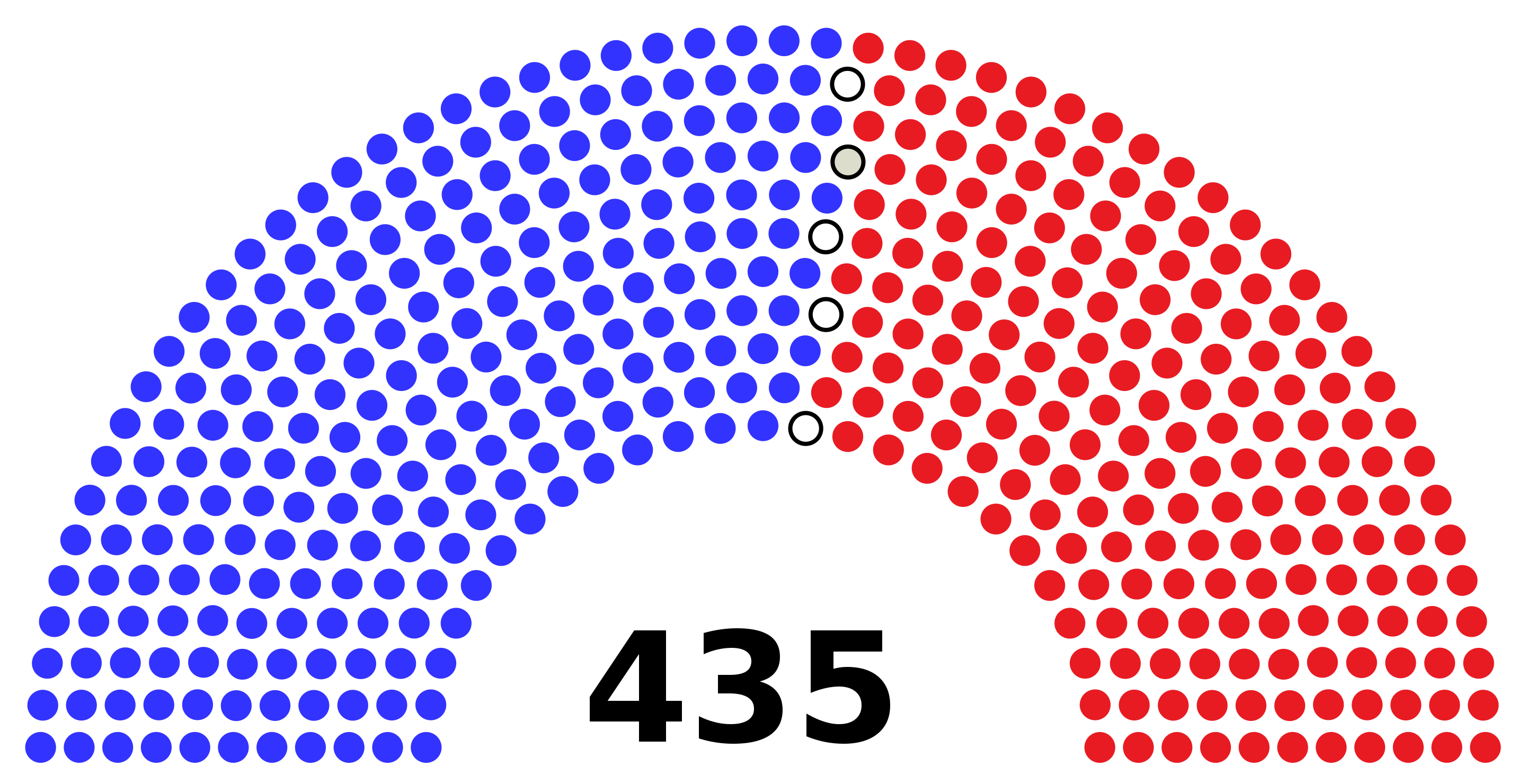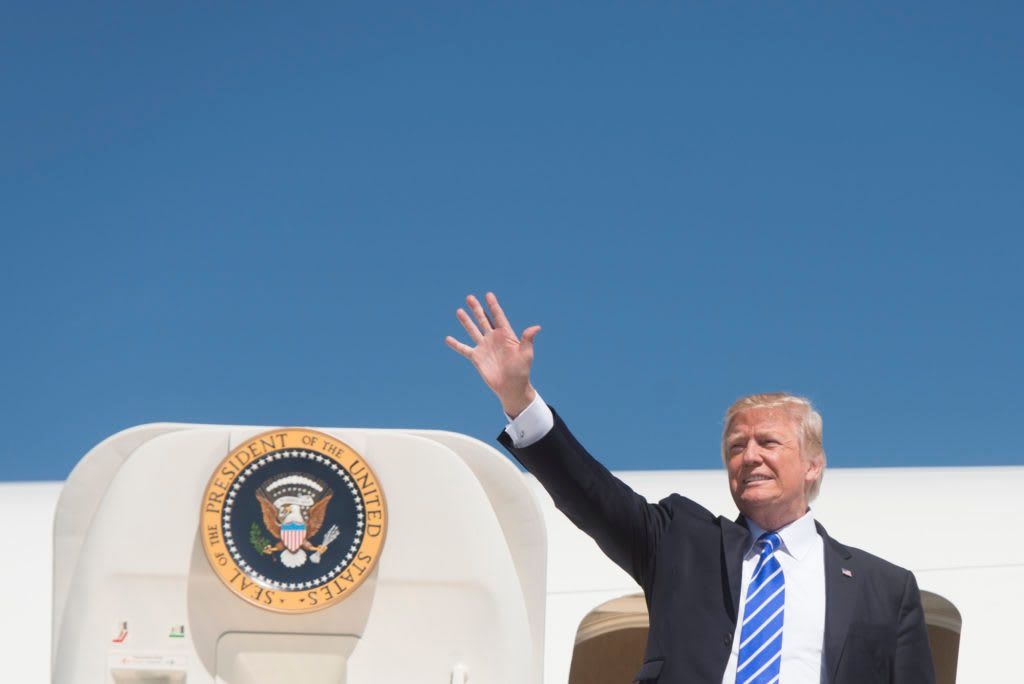Tangle is an independent, ad-free, non-partisan politics newsletter where I answer reader questions from across the country. If you found Tangle online, you can subscribe below.
Today’s read: 12 minutes.
It’s a little longer than usual, but you won’t have to read anything else on impeachment. If you want to read more about a certain subject, there are hyperlinks throughout that source the stuff I’m saying.

Photo: The White House
Yesterday.
I polled you all with this question: “Would you want to read a Tangle that zooms out on impeachment and gives a basic overview of where we are now?” Hundreds of you responded (thank you!) and the response was pretty unanimous, so we’re going to dive in. You can see the results here:

What happened.
On August 12th, 2019, an explosive “whistleblower complaint” was filed with the intelligence community inspector general. This is the person who oversees the conduct of America’s intelligence apparatuses. In the complaint, the whistleblower alleged that he had “received information from multiple U.S. Government officials that the President of the United States is using the power of his office to solicit interference from a foreign country in the 2020 U.S. election. This interference includes, among other things, pressuring a foreign country to investigate one of the President’s main domestic political rivals.”
The complaint went on to describe a July 25th phone call between Donald Trump and Ukraine’s president Volodymyr Zelensky. In that call, the whistleblower alleged, the president sought to pressure the Ukrainian leader to “initiate or continue an investigation into the activities of former Vice President Joseph Biden and his son, Hunter Biden.” He also asked that Zelensky “assist in purportedly uncovering that allegations of Russian interference in the 2016 U.S. presidential election originated in Ukraine.”
On August 28th, Politico published an article revealing that crucial military aid to Ukraine was being slow-walked. On September 9th, three House committees launched investigations into allegations that Trump, his lawyer Rudy Giuliani and other administration officials were pressuring Ukraine to help Trump’s re-election. On September 11th, the aid to Ukraine was released. By September 19th, the public had learned that the whistleblower complaint involved investigating the Bidens. Explanations for the sudden release of military aid varied: Some said it was because Senate Democrat Dick Durbin threatened to hold up a $5 billion spending bill, and others said it was because Trump was waiting for assurances Zelensky was serious about fighting corruption. Today, Democrats believe the aid was released because of the announcement of investigations, and the White House was trying to cover its tracks.
In the days that followed, more details of the whistleblower complaint made its way to the press. Rep. Adam Schiff told reporters that the inspector general deemed the complaint credible and a matter of urgent concern. Procedurally, that meant the complaint needed to be forwarded to the Director of National Intelligence, who would forward it to Congress. In this case, when the DNI (Joseph Maguire) got the complaint, he never alerted Congress, instead alerting the Justice Department, which told him to drop it.
Immediately, the complaint set off a media frenzy. The New York Times revealed parts of the whistleblower’s identity, in a story alleging he was a member of the CIA and detailed to the National Security Council. Other press reports and leaks put together that the subject of the whistleblower complaint was Trump trying to pressure Zelensky into investigating Joe or Hunter Biden. Details also leaked that the administration had taken the unusual step of putting a transcript of Trump’s call onto a secret, classified server to cover it up (one witness testified under oath that this was done by mistake, an excuse Democrats have been skeptical of). Towards the end of September, the whistleblower complaint was made public in its entirety, and it matched the news reports about its details.
Impeachment.
As details of the complaint and call began leaking to the press, calls for Trump to be impeached mounted. Democrats initially resisted. On September 24th, before President Trump had released a transcript of his call with Zelensky and before the full whistleblower complaint (and the details above) were available to the public, House Majority Leader Nancy Pelosi announced a formal impeachment inquiry into Trump. The announcement was a big turn of events for Pelosi, who had resisted impeachment fearing that it would politically benefit Trump — and perhaps put House Democrats who had been elected in pro-Trump districts at risk of losing their seats in 2020.
An impeachment happens in a few phases, and the House of Representatives has wide discretion on how to conduct an inquiry (the constitution is very broad about impeachment). Democrats control the House, the lower chamber of Congress, which means they get to make a lot of the rules.
- The House of Representatives votes on rules for an impeachment inquiry, including how to subpoena witnesses, how to question them, and what is made public.
- The House holds an impeachment inquiry, with closed-door and public testimony (that’s what has been happening these last few weeks).
- The House drafts formal articles of impeachment, or what they are accusing the president of, and sends it to the House Judiciary Committee. That is going to happen in the coming weeks.
- The House Judiciary Committee votes on whether to approve those articles and send them to the full chamber for a vote. They may even hold another public hearing to lay out what the House Intelligence Committee drafted up. This is likely to happen after Thanksgiving recess.
- The articles are sent to the full chamber, where House Democrats are expected to vote for impeachment along party lines (Democrats outnumber Republicans 233-197 in the House). It’s possible a couple of Democrats in pro-Trump districts vote no on impeachment, and it looks unlikely any Republicans will vote yes. Still, Democrats just need a simple majority — which looks probable.
- If the House impeaches the president, that will send everything to Congress’s “upper chamber,” the Senate. The Senate will then hold a trial. Trump can only be removed from office if the Senate votes with a supermajority (two-thirds of the 100 Senators, or 67 votes) to remove him.
- Given that the Senate is controlled by Republicans (53-47), this would require 20 Republicans “flipping” against Trump — an unlikely prospect right now.
- Senate Republicans could also use a procedural vote to stop a trial from happening at all if they build unanimous consent on the right that the president has done nothing wrong.
Only two presidents before Trump have been formally impeached (Johnson and Clinton), and both were acquitted by the Senate. Johnson ultimately served out his term and then later was elected to the Senate. Clinton was impeached for lying under oath and obstruction, acquitted by the Senate, and left office with a fairly strong approval rating. Richard Nixon was also headed towards impeachment but resigned before the House could vote on impeachment, as it appeared certain they were going to remove him. No president has ever been impeached and removed from office in the Senate.

Current makeup of the House of Representatives (233 Democrats, 197 Republicans, 4 vacancies, and one independent). Image: WikiCommons
The call transcript.
After initially refusing to release the call transcript, and generally labeling the new probe “fake news” and a “witch hunt,” Trump made an unexpected about-face. He announced that he’d share a public transcript of the July 25th call, and days later he followed through. On September 26th, the call transcript became public. Some journalists were careful to label it as a “memo” because it was filled with ellipses and appeared far too short to cover a 30-minute phone call. You can read the transcript here, but the part seized on by Democrats is below:

When the call was released, most of the political world was shocked. Privately, Republicans thought the call was damning — despite the White House claiming it totally exonerated the president. Publicly, several defenses emerged from the right: that the call showed no pressure, that Trump was clearly concerned about corruption in Ukraine, that no quid pro quo took place, etc. Democrats read the transcript and saw the obvious power dynamics: The President of the United States was asking a brand new leader of a foreign country to look into his top political foe, and withholding hundreds of millions of dollars of military aid while he did it. A proverbial shouting match began, with the left saying the president was so incompetent he released damning evidence of himself and the right saying the call showed there was no explicit quid pro quo.
Biden & Ukraine.
Amidst all of the impeachment stuff, there has been a lot of talk about Joe Biden. Republicans have been pushing the narrative that Trump’s calls for investigating Burisma, a gas company in Ukraine, and Joe Biden and his son, were legitimate. Their story goes like this: Joe Biden was Vice President while his son was making $50,000 a month on the board of Burisma. At the time, a Ukrainian prosecutor was investigating that gas company for corruption. Biden went to Ukraine, told the Ukrainian officials that the U.S. wouldn’t hand over financial aid unless the prosecutor resigned, and ultimately forced him out. All of this proves Biden was corrupt and Trump was well within reason to call for an investigation into him.
This story has been pushed by Trump’s lawyer, Rudy Giuliani, who witnesses have testified was helping run Trump’s foreign policy in Ukraine. Giuliani was in constant contact with Ukrainian officials and Trump was telling his own State Department to run Ukrainian-related policy through Giuliani, which senior diplomats testified this week was troubling and frustrating. It appears Giuliani was the point man for pressuring Ukrainian officials into announcing an investigation into Biden.
The story they’re telling has threads of truth. Hunter Biden was on the board of Burisma and was making insane amounts of money. He was underqualified for the position. They were being investigated by the Ukrainian prosecutor and Joe Biden did go to Ukraine and strongarm the prosecutor into resigning. The parts of the story they aren’t telling is that Biden and the U.S. were actually forcing the prosecutor out because of a global consensus that the prosecutor, in fact, was corrupt. The investigation into Burisma was “dormant” at the time. According to well-documented news stories around the push, Biden was forcing out the prosector in an effort to get Obama to give more military aid to Ukraine. Obama was hesitant because of the country’s history of corruption and because so few people trusted that Ukrainian prosecutor.
Republicans have also pushed the theory that Ukraine meddled in the 2016 election and acted against Trump, which is why he was so resistant to give them money. Trump has repeatedly pushed this theory by referencing CrowdStrike, a debunked conspiracy theory I won’t get into here. But House Republicans have pushed this theory by referencing a much more legitimate 2017 Politico story on how Ukrainian officials worked to hurt Trump’s election chances. This version of the story also has kernels of truth. There were some Ukrainian officials who openly despised Trump, and Politico did report on Ukanian attempts to undermine parts of the Trump campaign. But Politico also noted that those efforts were not concerted, were not top-down, and were not organized. It was just people in Ukraine who didn’t want him to be president. It also turned out that Paul Manafort, Trump’s former campaign manager and a shrewd political operative who is now in prison, was one of the main sources of the talking point that Ukraine interfered in 2016.
What we’ve learned.
Over the last few weeks, nine witnesses have testified publicly and a few more privately over the events that transpired around and after the July 25th call. Some witnesses, like Rudy Giuliani, Chief of Staff Mick Mulvaney and former National Security Adviser John Bolton, were blocked by the White House from appearing or are defying subpoenas. I wrote about how that’s possible here.
The witnesses who did appear had at times conflicting testimony but ultimately painted a picture of disarray over Ukraine policy. There appeared to be two channels: a more traditional group of career diplomats trying to run Ukraine policy, and another group that included Trump’s lawyer Giuliani and Trump donor Gordon Sondland (who was appointed as Ambassador to the European Union). The Trump group was running point on this campaign to get Zelensky to announce investigations on television. Some witnesses testified that the investigations weren’t even necessary, just the announcement, giving credence to Democrats’ claims that this was all political. The other group was trying to run more traditional diplomatic relationships, often becoming frustrated that Giuliani was involved, that unordinary meetings were taking place and that military aid was being withheld.
The Republican perspective is that most of the witnesses called forward did not have firsthand accounts of Trump directing a quid pro quo. They’ve leaned into the defense that it’s all hearsay and that the president never explicitly called for a quid pro quo. Instead, his actions were being interpreted in the most negative light possible by diplomats across the bureaucratic system. They’ve also argued that his resistance to hand over aid and call for investigations was warranted because Ukraine is corrupt and Biden acted corruptly. Finally, they make the point that Ukraine got its military assistance, Zelensky met with the president, people on the July 25th call had varied reactions to it and investigations never happened — so clearly quid pro quo wasn’t acted on.
Democrats’ perspective is that the whistleblower complaint has been verified entirely, despite Trump blocking firsthand witnesses from appearing. Trump’s own transcript shows he was making an ask to investigate Biden. Several witnesses have testified that the diplomats across the State Department understood what Trump was doing. The withheld aid was the pressure, as was a White House meeting that U.S. diplomats dangled in front of Zelensky (Sondland testified Wednesday that when it came to a White House meeting in exchange for investigations, it was clear to him there was a quid pro quo). Not only did Zelensky understand, he actually scheduled a CNN appearance to give Trump what he wanted: an announcement of investigations. That announcement was only canceled after the Politico story broke and pressure mounted to release the aid. And the aid was only released after an investigation into why it was being held was announced.
My take.
I watched about 85% of the impeachment hearings this week. I’ve read hundreds of articles related to impeachment from The New York Times, Fox News, WSJ, The Washington Post, The Federalist, HuffPost, Breitbart News, Politico, Axios, The Daily Caller and NBC, among others. I’ve watched all the big cable channels cover it. I’ve read through witness testimony, the call transcripts, the old articles, the whistleblower complaint. I’ve gone down the rabbit hole of commentary and conspiracy theories on Twitter and Facebook.
Ultimately, the conclusion I’ve come to on the central question — “Did Trump pressure a foreign leader into investigating his political opponent?” — is yes, he did. The evidence is overwhelming, not just from “career diplomats” being labeled as “Never-Trumpers,” but also from staunch Trump allies, Trump himself, moderate Republicans and even off-the-record supporters of Trump. They’ve admitted it in various ways on television and under oath. Every witness who was literate about the politics of Ukraine and U.S. relations ultimately conceded that they didn’t like what was happening and it was clear to them some kind of pressure was being exerted to open investigations. Notably, not a single witness explicitly said Trump was innocent of pressuring Ukraine into investigating Biden. Some have claimed they didn’t know his true intent. Others have admitted they were working off of presumption and what they heard. But none of those witnesses expressed any confidence that Trump was not interested in Biden or defended the contents of the call. The ones who did opine on what happened said the pressure was there, and it involved swapping a White House meeting — and in some cases military aid — in exchange for the announcement of investigations. To my surprise, even Peggy Noonan of the Wall Street Journal agrees with me (though she ultimately lands on leaving it to the voters).
Did Joe Biden act corruptly as Vice President? It doesn’t appear so to me. Was Hunter Biden’s role highly suspect and unethical? Yes. Did it create the appearance of a conflict of interest? As most witnesses testified, yes. Were there Ukrainian officials who did not like Trump? Yes. Were there U.S. diplomats working for him who clearly loathed Trump’s foreign policy? Yes. Does any of this change my conclusion about the central question of the inquiry? No.
The question now is whether this is an impeachable offense. Frankly, I’m on the fence. Just last week I wrote that it was. Since then I’ve wavered. On its own, it could be taken as extraordinarily bad judgment. But a crime? Bribery? Extortion? It can be tough to fit the unsaid pressure, the implied and explicit exchange, into a neat criminal definition. Previous impeachments had clear evidence law was broken. But when you zoom out and you take Trump as a whole — the obstruction, the other fraudulent crimes he’s committed, the lies, the obvious intent to leverage his power as president against Biden, the damage he could have done to Ukraine had the whistleblower not come forward — all of that makes me think it’s impeachable. Ultimately, attempting to do a crime and not completing it is not exculpatory evidence of innocence. Nor is being so incompetent you couldn’t complete the attempted crime. The damage from Trump’s actions could have been catastrophic and the only reason the outcome wasn’t so bad is that a whistleblower — who Trump and his allies now want to out — came forward and told the story.
Unfortunately, my opinion doesn’t matter. Yesterday, moderate House Republican Will Hurd made it clear he was a “no” on impeachment. Hurd is a retiring Republican with nothing to lose who is no fan of Trump. The reporter Tim Alberta also shared on Twitter that even Mark Sanford, a Republican who was running to unseat Trump just a few weeks ago, also said he would vote against impeachment if he were still in the House. Sanford’s political career is truly finished, and he honestly hates Trump, so if he and Hurd are not coming over — I don’t know what Republicans are. Trump’s firewall is that nearly 90 percent of Republican voters still support him, and any Republican who moves to impeach him will ultimately risk losing their own seat. All this makes what’s next a foregone conclusion, to me: Democrats will impeach Trump in the House and the Senate will acquit him. Or they’ll stop a trial from even happening. Then two competing impeachment stories will be presented in the 2020 presidential race, and voters will ultimately decide who they want their next president to be.
Was this helpful?
This is a special edition of my daily newsletter, Tangle. It’s ad-free, indie, and non-partisan. If you want to subscribe, press the button below. If you want to support the newsletter, share it on social media or forward this email to some friends!
Have a nice day.
There’s a lot here! Wash it down with this hilarious C-SPAN caller who really cracked me up (Warning: explicit language).



Member comments